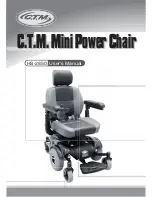
20
HD balance
5. TRANSPORT
5.1 Transport of wheelchair with patient in vehicles
The HD balance must be tied in place in the vehicle with a 4-point
belt system, see Diagram 48, and the user must use a 3-point
safety belt. Both must be approved according to ISO 10542-2. All
transportation must be done with the wheelchair facing forwards!
See Diagram 49.
When clamping fast, the rear tension device is attached to the
intended mounts on the wheel frame, see 1 in Diagrams 48 & 50.
The front tension device is attached around the wheel frame’s cross
tube as 2 in Diagrams 48 & 51. These attachment points are marked
with the symbol described in section
“2.7 Signs/Markings”
.
- No other attachment points than those specified may be used!
THE FOLLOWING MUST BE CONSIDERED BEFORE TRANSPORT:
- Table, thoracic support and other accessories must be removed.
- The headrest/neckrest must be used.
- The wheelchair seat and back (angle) must be positioned as upright
as possible.
- The wheelchair legrests must be angled down as much as possible.
- Do not use too much tension. Tensioners should only be tightened so
that the wheelchair is stable. Any “Rocking” may not be offset by tighten-
ing the straps tighter. Tensioning devices can create excessive loads on
the wheels and frame components and thereby damage the wheelchair.
- The user must always use the vehicles fixed system of three-point
safety belts. Any positioning/safety belts that are mounted on the
wheelchair and are usually used by the patient may not be used as
substitutes for seat belts when traveling in vehicles.
The HD Balance is crash tested according to ISO 7176-19:2008,
see Section 9.1, which means that it has been tested and passed the
requirements of a standard test. The test simulates a frontal colli-
sion at 48km/hr with a test dummy weighing 79.2kg. The standard
specifies a minimum requirement for what the wheelchair must
handle regarding transport in a vehicle.
Since an actual incident is likely to be different than the conditions
at the time of testing, HD Rehab does not accept any responsibility
for the outcome of an accident in which the HD balance is involved.
5.2 Weight of removable components
Wheel 24” - 2.0 kg
Wheel 16” - 1.85 kg
Legrest - 2.4 kg
Armrest - 1.1 kg
Seat cushion - ca 1.1 kg
Back cushion - ca 0.8 kg.
!
Diagram 48.
Wheelchair
with clamp mounted.
Diagram 49.
All transport must be forward facing!
Diagram 50.
Rear transport
mount.
Diagram 51.
Front tension-
ing during transport.
1
2
2
1





































